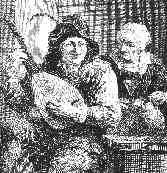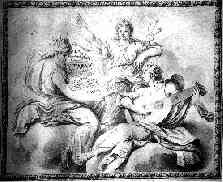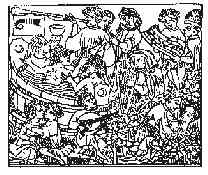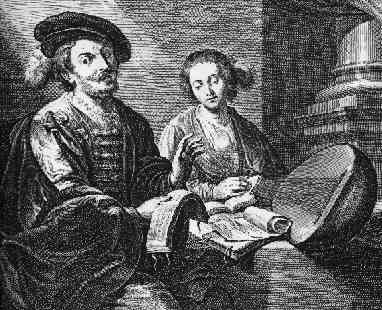|
 |
 |
Lute music, one of the
great treasures of our musical culture, has only been rediscovered in
recent times - and is still unknown to many potential admirers. For a
long time, lute was the most important instrument in secular
music-making in Europe; its position was comparable to that of the piano
today. Travelling virtuosos were received by princes and potentates, but
there were also many dilettante lutenists among the middle classes, the
nobility and the beggars. People played in the privacy of their homes,
at courtly festivities, during private devotations, below the window of
their beloved, at the hairdresser's, in the baths, or alone, sitting on
a rock in the open air - scenes which are documented on a number of
canvasses. The highly developed performancy techniques and the technical
demand of the compositions required a training which aspired to the
humanistic ideal of the sensitive and refined individual. The expressive
possibilities of this instrument, whose up to 24 strings produced a
delicate, austained resonance, ranged from lively, occasionally even
ribald dances to the depiction of subtle, dream-like emotions. The lute
was sometimes called "the flattering instrument" because of
its warm, colourful and flexible tone |
|
|
 |
La musique pour
le luth est un des grands trésors de notre culture musicale,
redécouvert il y peu de temps et ignoré encore par bien
des amateurs de musique. Pendant longtemps, le luth fut l'instrument le
plus important en Europe; il occupa une place comparable à celle
qu'a aujourd'hui le piano. A côté des virtuoses ambulants,
courtisés des seigneurs les plus puissants, le luth était
pratiqué par des amateurs bourgeois et nobles autant que par des
mendiants. On en jouait dans l'intimité aussi bien qu'aux
festivités de la cour, aux heures de prière comme sous la
fenêtre de la bien-aimée; on jouait du luth chez le
barbier, au bain ou - comme en témoignent nombre de représentations
- assis sur un roc, seul dans la nature. Une technique de jeu poussée
et un répertoire de très haut niveau exigeaient une
formation conforme à l'idéal humaniste de l'âme
sensible et cultivée. Cet instrument universel, dont les cordes -
leur nombre peut atteindre 24 - engendrent des résonances fines,
dispose de possibilités d'expression qui vont de la gaîté,
voire gaillardise des danses, jusqu'à la rêverie subtile et
mélancolique. Le lute était souvent considéré
comme "l'instrument de charme" par excellence du fait de son
timbre chaud, coloré et versatile. |
|
|
 |
Die Lautenmusik
gehört zu den großen Schätzen unserer Musikkultur, die
erst in jüngerer Zeit wiederentdeckt wurden und vielen potentiellen
Liebhabern noch unbekannt sind. Lange Zeit war die Laute das wichtigste
Musikinstrument in Europa; ihre damalige Stellung ist mit der Bedeutung
des Klaviers im heutigen Musikleben vergleichbar. Es gab reisende
Virtuosen, die selbst von einflußreichen Potentaten hofiert
wurden, dilettierende Bürger, Edelleute und Bettler, die diese
Kunst beherrschten. Man spielte in der Kammer, auf höfischen
Festen, bei der häuslichen Andacht, unter dem Fenster der
Geliebten, beim Friseur, im Bad oder einsam auf einem Stein sitzend in
freier Natur, was zahlreiche Darstellungen belegen. Die hochentwickelte
Spieltechnik und anspruchsvolle Kompositionen verlangten eine Schulung,
die dem humanistischen Ideal des sensibel-verfeinerten Menschen
entsprach. Von ausgelassener, mitunter deftiger Tanzfreude bis zur
Darstellung träumerisch-subtiler Empfindungen reichen die
Ausdrucksmöglichkeiten des "vielsaitigen" Instruments,
dessen bis zu 24 Saiten eine anhaltende, feine Resonanz erzeugen. Wegen
ihres warmen, farbigen und wandelbaren Tons nannte man die Laute "das
schmeichelnde Instrument". |
|
|
 |
La musica per
liuto rientra fra i grandi tesori della nostra cultura musicale,
riscoperti solo in tempi recenti e ancora sconosciuti ad un pubblico di
potenziali apprassionati. Per molto tempo il liuto è stato il più
importante strumento in Europa; occupava allora una posizione
comparabile a quella odierna del pianoforte. C'erano allora virtuosi del
liuto, continuamente in viaggio, ai quali persino influenti uomini di
potere rendevano omaggio; si dilettavano di liuto anche normali
cittadini, aristocratici e mendicanti. Il liuto si suonava in casa, alle
feste cortesi, nell'intimità familiare,sotto la finestra
dell'innamorata, dal parrucchiere, ai bagni oppure in solitudine, seduti
su una pietra in aperta campagna, come documentato in numerose
rappresentazioni delle arti grafiche. La tecnica di esecuzione altamente
sviluppata e le difficili composizioni richiedevano al suonatore una
vera e propria istruzione, il che rispondeva all'ideale umanistico
dell'uomo sensibile e raffinato. Il potenziale espressivo di questo
strumento "multicorde" spaziava dalla sfrenata e talvolta
mondana gioia della danza fino alla rappresentazione di sognanti e
sottili sensazioni. Il liuto, le cui corde possono persino raggiungere
un numero di 24, produce un suono elegante e duraturo. Per via del suo tòno
caldo, colorato e mutevole, il liuto fu chiamato "lo strumento
karezzévole". |



